Advances and Trends in Channel Codes for Underwater Acoustic Communications
Abstract
:1. Introduction
2. UWA Channel Model and Characteristics
2.1. Multi-Paths
2.2. Time-Vary Multi-Path Channel and Doppler
2.3. Noise and Channel Capacity
2.4. Requirements for Channel Coding
3. Channel Codes for UWAS
3.1. BCH and RS Codes
3.2. Convolutional Codes
3.3. Turbo Codes
3.4. LDPC Codes
3.5. Polar Codes
4. Discussion and Research Directions
4.1. Low-Complexity Channel Coding
4.2. Joint Channel Coding and Other Modules
4.3. Rate-Compatible Codes for Short-Block Data
5. Conclusions
- Under the uncertain marine environment, the fixed data rates of the underwater acoustic communication system make it difficult to ensure stable and efficient data transmission. Design low latency, little feedback, or no feedback modulation transmission strategies based on wide rate polar codes to fully utilize channel capacity, improve underwater acoustic transmission efficiency, and adapt to the environment and tasks.
- Considering the UACS’s energy resource constraints, the complexity of the coding algorithms needs to be optimized and combined with other modules to achieve an overall optimization of the system with less hardware and software overhead.
- Non-binary LDPC codes have been successfully applied to design underwater acoustic communication systems [15]. Research on the excellent characteristics of polar codes, as well as the non-binary polar codes, is noteworthy. Moreover, it is necessary to fully optimize encoding and decoding structures by studying the characteristics of underground acoustic channels in both deep and shallow water.
Author Contributions
Funding
Institutional Review Board Statement
Informed Consent Statement
Data Availability Statement
Conflicts of Interest
References
- Ma, Y.; Zhang, Q.; Wang, H. 6G: Ubiquitously extending to the vast underwater world of the oceans. Engineering 2022, 8, 12–17. [Google Scholar] [CrossRef]
- Xu, W.; Yan, S.; Ji, F. Marine information gathering, transmission, processing, and fusion: Current status and future trends. Sci. Sin. Inform. 2016, 46, 1053–1085. [Google Scholar] [CrossRef]
- Song, A.; Stojanovic, M.; Chitre, M. Editorial underwater acoustic communications: Where we stand and what is next? IEEE J. Ocean. Eng. 2019, 44. [Google Scholar] [CrossRef]
- Mohsan, S.A.H.; Li, Y.; Sadiq, M.; Liang, J.; Khan, M.A. Recent advances, future trends, applications and challenges of internet of underwater things (iout): A comprehensive review. J. Mar. Sci. Eng. 2023, 11, 124. [Google Scholar] [CrossRef]
- Stojanovic, M. On the relationship between capacity and distance in an underwater acoustic communication channel. ACM Sigmobile Mob. Comput. Commun. Rev. 2007, 11, 34–43. [Google Scholar] [CrossRef]
- Stojanovic, M.; Preisig, J. Underwater acoustic communication channels: Propagation models and statistical characterization. IEEE Commun. Mag. 2009, 47, 84–89. [Google Scholar] [CrossRef]
- Goalic, A.; Trubuil, J.; Beuzelin, N. Channel coding for underwater acoustic communication system. In Proceedings of the OCEANS 2006, Boston, MA, USA, 18–21 September 2006; pp. 1–4. [Google Scholar] [CrossRef]
- Stojanovic, M. OFDM for underwater acoustic communications: Adaptive synchronization and sparse channel estimation. In Proceedings of the 2008 IEEE International Conference on Acoustics, Speech and Signal Processing, Las Vegas, NV, USA, 31 March–4 April 2008; pp. 5288–5291. [Google Scholar] [CrossRef]
- Xiaomei, X.; Lan, Z.; Wei, F.; Yougan, C. RA coding joint adaptive equalization for underwater acoustic communications. In Proceedings of the 2010 IEEE 12th International Conference on Communication Technology, Nanjing, China, 11–14 November 2010; pp. 530–534. [Google Scholar] [CrossRef]
- Murad, M.; Tasadduq, I.A.; Otero, P. Ciphered BCH Codes for PAPR Reduction in the OFDM in Underwater Acoustic Channels. J. Mar. Sci. Eng. 2022, 10, 91. [Google Scholar] [CrossRef]
- Jiang, W.; Tao, Q.; Yao, J.; Tong, F.; Zhang, F. R&D of a low-complexity OFDM acoustic communication payload for Micro-AUV in confined space. EURASIP J. Adv. Signal Process. 2022, 2022, 64. [Google Scholar] [CrossRef]
- Zhou, Z.; Mo, H.; Zhu, Y.; Peng, Z.; Huang, J.; Cui, J.H. Fountain code based adaptive multi-hop reliable data transfer for underwater acoustic networks. In Proceedings of the 2012 IEEE international conference on communications (ICC), Ottawa, ON, Canada, 10–15 June 2012; pp. 6396–6400. [Google Scholar] [CrossRef]
- Hui, J.; Liu, L.; Liu, H.; Feng, H. A study on pattern time delay coding underwater acoustic communication. ACTA Acoust. 1999, 24, 561–573. [Google Scholar] [CrossRef]
- Xu, X.; Qiao, G.; Su, J.; Su, J.; Hu, P.; Sang, E. Study on turbo code for multicarrier underwater acoustic communication. In Proceedings of the 2008 4th International Conference on Wireless Communications, Networking and Mobile Computing, Dalian, China, 12–14 October 2008; pp. 1–4. [Google Scholar] [CrossRef]
- Huang, J.; Zhou, S.; Willett, P. Nonbinary LDPC coding for multicarrier underwater acoustic communication. IEEE J. Sel. Areas Commun. 2008, 26, 1684–1696. [Google Scholar] [CrossRef]
- Lidström, V. Evaluation of Polar-Coded Noncoherent Acoustic Underwater Communication. IEEE J. Ocean. Eng. 2023. [Google Scholar] [CrossRef]
- Hagenauer, J. Rate-compatible punctured convolutional codes (RCPC codes) and their applications. IEEE Trans. Commun. 1988, 36, 389–400. [Google Scholar] [CrossRef]
- Rowitch, D.N.; Milstein, L.B. On the performance of hybrid FEC/ARQ systems using rate compatible punctured turbo (RCPT) codes. IEEE Trans. Commun. 2000, 48, 948–959. [Google Scholar] [CrossRef]
- Ha, J.; Kim, J.; McLaughlin, S.W. Rate-compatible puncturing of low-density parity-check codes. IEEE Trans. Inf. Theory 2004, 50, 2824–2836. [Google Scholar] [CrossRef]
- Hong, S.N.; Hui, D.; Marić, I. Capacity-achieving rate-compatible polar codes. IEEE Trans. Inf. Theory 2017, 63, 7620–7632. [Google Scholar] [CrossRef]
- Wan, L.; Zhou, H.; Xu, X.; Zhou, S.H.; Shi, Z.J.; Cui, J.H. Adaptive modulation and coding for underwater acoustic OFDM. IEEE J. Ocean. Eng. 2014, 40, 327–336. [Google Scholar] [CrossRef]
- Su, R.; Venkstesan, R.; Ju, M.; Gong, Z.; Li, C. A review of channel modeling techniques for underwater acoustic communications. In Proceedings of the 19th IEEE Newfoundland Electrical and Computer Engineering, St. John’s, NL, Canada, 4 November 2010; pp. 1–5. [Google Scholar]
- Huang, J.; Berger, C.R.; Zhou, S.; Huang, J. Comparison of basis pursuit algorithms for sparse channel estimation in underwater acoustic OFDM. In Proceedings of the OCEANS’10 IEEE SYDNEY, Sydney, NSW, Australia, 24–27 May 2010; pp. 1–6. [Google Scholar] [CrossRef]
- Qin, X.; Diamant, R. Joint Channel Estimation and Decoding for Underwater Acoustic Communication with a Short Pilot Sequence. IEEE J. Oceanic Eng. 2023, 48, 526–541. [Google Scholar] [CrossRef]
- Yang, T.C. Properties of underwater acoustic communication channels in shallow water. J. Acoust. Soc. Am. 2012, 131, 129–145. [Google Scholar] [CrossRef]
- Cho, Y.H. Fast Sparse Bayesian Learning-Based Channel Estimation for Underwater Acoustic OFDM Systems. Appl. Sci. 2022, 12, 10175. [Google Scholar] [CrossRef]
- Han, Z.; Tao, W.; Zhang, D.; Jiang, P. Virtual Space-Time Diversity Turbo Equalization Using Cluster Sparse Proportional Recursive Least Squares Algorithm for Underwater Acoustic Communications. Appl. Sci. 2023, 13, 11050. [Google Scholar] [CrossRef]
- Shannon, C.E. A mathematical theory of communication. Bell Syst. Tech. J. 1948, 27, 379–423. [Google Scholar] [CrossRef]
- Shirvanimoghaddam, M.; Mohammadi, M.S.; Abbas, R.; Minja, A.; Yue, C.; Matuz, B.; Han, G.; Lin, Z.H.; Liu, W.C.; Li, Y.H.; et al. Short block-length codes for ultra-reliable low latency communications. IEEE Commun. Mag. 2018, 57, 130–137. [Google Scholar] [CrossRef]
- Islam, K.Y.; Ahmad, I.; Habibi, D.; Waqar, A. A survey on energy efficiency in underwater wireless communications. J. Netw. Comput. Appl. 2022, 198, 103295. [Google Scholar] [CrossRef]
- Gorenstein, D.; Zierler, N. A class of error-correcting codes in pm symbols. J. Soc. Ind. Appl. Math. 1961, 9, 207–214. [Google Scholar] [CrossRef]
- Widmer, H.P.; Lev, E.; Costabile, J.J. Demonstration of a Low-Frequency, Long-Range Acoustic Communications System. Johns Hopkins APL Tech. Dig. 1993, 14, 174. [Google Scholar]
- LeBlanc, L.R.; Beaujean, P.P.; Singer, M.; Boubli, C.; Strutt, G.T. Chirp FSK modem for high reliability communication in shallow water. In Proceedings of the Oceans’ 99. MTS/IEEE. Riding the Crest into the 21st Century. Conference and Exhibition. Conference Proceedings (IEEE Cat. No. 99CH37008), Seattle, WA, USA, 13–16 September 1999; Volume 1, pp. 222–227. [Google Scholar] [CrossRef]
- Stojanovic, M.; Freitag, L. Multiuser undersea acoustic communications in the presence of multipath propagation. In Proceedings of the MTS/IEEE Oceans 2001. An Ocean Odyssey. Conference Proceedings (IEEE Cat. No. 01CH37295), Honolulu, HI, USA, 5–8 November 2001; Volume 4, pp. 2165–2169. [Google Scholar] [CrossRef]
- Guo, S.; Zhao, Z.; Pan, Q. A CDMA acoustic communication system for multiple underwater robots. In Proceedings of the 2008 IEEE International Conference on Robotics and Biomimetics, Bangkok, Thailand, 22–25 February 2009; pp. 1522–1526. [Google Scholar] [CrossRef]
- Pompili, D.; Akyildiz, I.F. A multimedia cross-layer protocol for underwater acoustic sensor networks. IEEE Trans. Wirel. Commun. 2010, 9, 2924–2933. [Google Scholar] [CrossRef]
- Huang, Y.; Zhou, S.; Shi, Z.; Lai, L. Channel frequency response-based secret key generation in underwater acoustic systems. IEEE Trans. Wirel. Commun. 2016, 15, 5875–5888. [Google Scholar] [CrossRef]
- Barreto, G.; Simão, D.H.; Pellenz, M.E.; Souza, R.D.; Jamhour, E.; Penna, M.C.; Brante, G.; Chang, B.S. Energy-efficient channel coding strategy for underwater acoustic networks. Sensors 2017, 17, 728. [Google Scholar] [CrossRef]
- Niemann, E.; Nicolaides, K.; Dhuness, K. A prototype broadband acoustic underwater data communication system for high data rates. In Proceedings of the OCEANS 2021, San Diego, CA, USA, 20–23 September 2021; pp. 1–6. [Google Scholar] [CrossRef]
- Reed-Solomon Codes and Their Applications; John Wiley & Sons: Hoboken, NJ, USA, 1999. [CrossRef]
- Trubuil, J.; Goalic, A.; Beuzelin, N. Synchronization and channel coding in shallow water acoustic communication. In Proceedings of the OCEANS 2008, Quebec, QC, Canada, 15–18 September 2008; pp. 1–5. [Google Scholar] [CrossRef]
- Goalic, A.; Trubuil, J.; Laot, C.; Beuzelin, N. Underwater acoustic communication using Reed Solomon Block Turbo Codes channel coding to transmit images and speech. In Proceedings of the OCEANS 2010 MTS/IEEE SEATTLE, Seattle, WA, USA, 20–23 September 2010; pp. 1–6. [Google Scholar] [CrossRef]
- Nie, X.; Xu, W.; Zheng, J. Time reversal acoustic communication with concatenated reed-solomon code. In Proceedings of the 2012 Oceans-Yeosu, Yeosu, Republic of Korea, 21–24 May 2012; pp. 1–4. [Google Scholar] [CrossRef]
- Esmaiel, H.; Jiang, D. Image transmission over underwater acoustic environment using OFDM technique with HQAM mapper. In Proceedings of the 2013 IEEE Third International Conference on Information Science and Technology (ICIST), Yangzhou, China, 23–25 March 2013; pp. 1596–1601. [Google Scholar] [CrossRef]
- Diamant, R.; Lampe, L. Adaptive error-correction coding scheme for underwater acoustic communication networks. IEEE J. Ocean. Eng. 2014, 40, 104–114. [Google Scholar] [CrossRef]
- Khanai, R.; Shahapur, S.S.; Torse, D. Performance analysis of underwater acoustic communication using IDMA-OFDM-MIMO with Reed Solomon and turbo code. Int. J. Comput. Netw. Inf. Secur. 2018, 10, 41–46. [Google Scholar] [CrossRef]
- Sklivanitis, G.; Pelekanakis, K.; Yıldırım, S.A.; Petroccia, R.; Alves, J.; Pados, D.A. Physical layer security against an informed eavesdropper in underwater acoustic channels: Reconciliation and privacy amplification. In Proceedings of the 2021 Fifth Underwater Communications and Networking Conference (UComms), Lerici, Italy, 31 August–2 September 2021; pp. 1–5. [Google Scholar] [CrossRef]
- Viterbi, A. Convolutional codes and their performance in communication systems. IEEE Trans. Commun. Technol. 1971, 19, 751–772. [Google Scholar] [CrossRef]
- Moon, T.K. Error Correction Coding: Mathematical Methods and Algorithms; John Wiley & Sons: Hoboken, NJ, USA, 2020. [Google Scholar]
- Catipovic, J.; Deffenbaugh, M.; Freitag, L.; Frye, D. An acoustic telemetry system for deep ocean mooring data acquisition and control. In Proceedings of the Oceans, Seattle, WA, USA, 18–21 September 1989; Volume 3, pp. 887–892. [Google Scholar] [CrossRef]
- Catipovic, J.A.; Baggeroer, A.B. Performance of sequential decoding of convolutional codes over fully fading ocean acoustic channels. IEEE J. Ocean. Eng. 1990, 15, 1–7. [Google Scholar] [CrossRef]
- Lam, W.K.; Ormondroyd, R.F. A coherent COFDM modulation system for a time-varying frequency-selective underwater acoustic channel. In Proceedings of the Seventh International Conference on Electronic Engineering in Oceanography—Technology Transfer from Research to Industry, Southampton, UK, 23–25 June 1997. [Google Scholar] [CrossRef]
- Stojanovic, M.; Proarkis, J.G.; Rice, J.A.; Rice, J.A.; Green, M.D. Spread spectrum underwater acoustic telemetry. In Proceedings of the IEEE Oceanic Engineering Society. OCEANS’98. Conference Proceedings (Cat. No. 98CH36259), Nice, France, 28 September–1 October 1998; Volume 2, pp. 650–654. [Google Scholar] [CrossRef]
- Zhu, W.-Q.; Wang, C.-H.; Pan, F.; Zhu, M.; Wang, R.; Zhang, X.-J.; Dai, Y.-M. Underwater acoustic communication system of AUV. In Proceedings of the IEEE Oceanic Engineering Society. OCEANS’98. Conference Proceedings (Cat. No. 98CH36259), Nice, France, 28 September–1 October 1998; Volume 1, pp. 477–481. [Google Scholar] [CrossRef]
- Blackmon, F.; Sozer, E.; Murandian, M.; Proakis, J.; Salehi, M. Performance comparison of iterative/integral equalizer/decoder structures for underwater acoustic channels. In Proceedings of the MTS/IEEE Oceans 2001. An Ocean Odyssey. Conference Proceedings (IEEE Cat. No. 01CH37295), Honolulu, HI, USA, 5–8 November 2001; Volume 4, pp. 2191–2200. [Google Scholar] [CrossRef]
- Park, J.; Seo, C.; Park, K.C.; Yoon, J.R. Effectiveness of convolutional code in multipath underwater acoustic channel. Jpn. J. Appl. Phys. 2013, 52, 07HG01. [Google Scholar] [CrossRef]
- de Souza, F.; Souza, R.; Brante, G.; Pellenz, M.; Rosas, F.; Chang, B. Code rate optimization for energy efficient delay constrained underwater acoustic communications. In Proceedings of the OCEANS 2015-Genova, Genova, Italy, 18–21 May 2015; pp. 1–4. [Google Scholar] [CrossRef]
- de Souza, F.; Souza, R.; Brante, G.; Souza, R.D.; Pellenz, M.E.; Rosas, F. Optimizing the number of hops and retransmissions for energy efficient multi-hop underwater acoustic communications. IEEE Sens. J. 2016, 16, 3927–3938. [Google Scholar] [CrossRef]
- Behgam, M.; Zheng, Y.R.; Liu, Z. Coding for short messages in multipath underwater acoustic communication channels. In Proceedings of the OCEANS 2018 MTS/IEEE Charleston, Charleston, SC, USA, 22–25 October 2018; pp. 1–5. [Google Scholar] [CrossRef]
- Lee, H.S.; Jung, J.W.; Baek, C.U.; Lee, A.H.; Kim, W.J. Adaptive modulation and coding for underwater acoustic communication. In Proceedings of the 2019 Eleventh International Conference on Ubiquitous and Future Networks (ICUFN), Zagreb, Croatia, 2–5 July 2019; pp. 54–56. [Google Scholar] [CrossRef]
- Wu, F.Y.; Tian, T.; Su, B.X.; Song, Y.C. Hadamard–Viterbi Joint Soft Decoding for MFSK Underwater Acoustic Communications. Remote Sens. 2022, 14, 6038. [Google Scholar] [CrossRef]
- Wang, J.; Zhang, S.; Luo, P.; Zhao, X. A Strong Security Key Agreement Scheme for Underwater Acoustic Networks. In Proceedings of the International Conference on Innovative Computing, Singapore, 1–3 February 2023; Springer Nature Singapore: Singapore, 2023; pp. 666–677. [Google Scholar] [CrossRef]
- Berrou, C.; Glavieux, A.; Thitimajshima, P. Near Shannon limit error-correcting coding and decoding: Turbo-codes. 1. In Proceedings of the ICC’93-IEEE International Conference on Communications, Geneva, Switzerland, 23–26 May 1993; Volume 2, pp. 1064–1070. [Google Scholar] [CrossRef]
- Tuchler, M.; Koetter, R.; Singer, A.C. Turbo equalization: Principles and new results. IEEE Trans. Commun. 2002, 50, 754–767. [Google Scholar] [CrossRef]
- Zheng, Y.R.; Wu, J.; Xiao, C. Turbo equalization for single-carrier underwater acoustic communications. IEEE Commun.-Tions Mag. 2015, 53, 79–87. [Google Scholar] [CrossRef]
- Jasim, S.; Abbas, A. Performance of turbo code with different parameters. J. Univ. Babylon 2017, 25, 1684–1692. [Google Scholar]
- Sozer, E.M.; Proakis, J.G.; Blackmon, F. Iterative equalization and decoding techniques for shallow water acoustic channels. In Proceedings of the MTS/IEEE Oceans 2001. An Ocean Odyssey. Conference Proceedings (IEEE Cat. No. 01CH37295), Honolulu, HI, USA, 5–8 November 2001; Volume 4, pp. 2201–2208. [Google Scholar] [CrossRef]
- Huang, J.; Sun, J.; He, C.; Sheng, X.H.; Zhang, Q.F. High-speed underwater acoustic communication based on OFDM. In Proceedings of the 2005 IEEE International Symposium on Microwave, Antenna, Propagation and EMC Technologies for Wireless Communications, Beijing, China, 8–12 August 2005; Volume 2, pp. 1135–1138. [Google Scholar] [CrossRef]
- Roy, S.; Duman, T.M.; McDonald, V.; Proakis, J.G. High-rate communication for underwater acoustic channels using multiple transmitters and space–time coding: Receiver structures and experimental results. IEEE J. Ocean. Eng. 2007, 32, 663–688. [Google Scholar] [CrossRef]
- Labrador, Y.; Karimi, M.; Pan, D.; Miller, J. Modulation and error correction in the underwater acoustic communication channel. Int. J. Comput. Sci. Netw. Secur. 2009, 9, 123–130. [Google Scholar]
- Iruthayanathan, N.; Vishvaksenan, K.S.; Rajendran, V.; Mohankumar, S. Performance analysis of turbo-coded MIMO–OFDM system for underwater communication. Comput. Electr. Eng. 2015, 43, 1–8. [Google Scholar] [CrossRef]
- Bocus, M.J.; Agrafiotis, D.; Doufexi, A. Non-orthogonal multiple access (NOMA) for underwater acoustic communication. In Proceedings of the 2018 IEEE 88th Vehicular Technology Conference (VTC-Fall), Chicago, IL, USA, 27–30 August 2018; pp. 1–5. [Google Scholar] [CrossRef]
- Bocus, M.J.; Doufexi, A.; Agrafiotis, D. Performance of OFDM-based massive MIMO OTFS systems for underwater acoustic communication. IET Commun. 2020, 14, 588–593. [Google Scholar] [CrossRef]
- Minaeva, O.N.; Miroshnikova, N.E.; Sattarova, A.I. Research of the Convolutional and Product Turbo Codes Characteristics in Conditions of Underwater Channel. In Proceedings of the 2022 Systems of Signals Generating and Processing in the Field of on Board Communications, Moscow, Russian, 15–17 March 2022; pp. 1–5. [Google Scholar] [CrossRef]
- Yang, Y.; Li, Y. Research and Implementation of Turbo Coding Technology in High-Speed Underwater Acoustic OFDM Communication. J. Robot. 2022, 2022, 2576303. [Google Scholar] [CrossRef]
- Jeong, H.W.; Jung, J.W.; Kim, I.S. Non-coherent turbo coded frequency shift keying for reliable covert underwater acoustic communications. J. Acoust. Soc. Am. 2022, 151, A235. [Google Scholar] [CrossRef]
- Thorpe, J. Low-density parity-check (LDPC) codes constructed from protographs. IPN Prog. Rep. 2003, 42, 42–154. [Google Scholar]
- Richardson, T.; Kudekar, S. Design of low-density parity check codes for 5G new radio. IEEE Commun. Mag. 2018, 56, 28–34. [Google Scholar] [CrossRef]
- Richardson, T.J.; Urbanke, R.L. Efficient encoding of low-density parity-check codes. IEEE Trans. Inf. Theory 2001, 47, 638–656. [Google Scholar] [CrossRef]
- Kou, Y.; Lin, S.; Fossorier, M.P.C. Low-density parity-check codes based on finite geometries: A rediscovery and new results. IEEE Trans. Inf. Theory 2001, 47, 2711–2736. [Google Scholar] [CrossRef]
- Li, Z.; Chen, L.; Zeng, L.; Fong, W.H. Efficient encoding of quasi-cyclic low-density parity-check codes. IEEE Trans. Commun. 2006, 54, 71–81. [Google Scholar] [CrossRef]
- Dehghan, A.; Banihashemi, A.H. On the Tanner graph cycle distribution of random LDPC, random protograph-based LDPC, and random quasi-cyclic LDPC code ensembles. IEEE Trans. Inf. Theory 2018, 64, 4438–4451. [Google Scholar] [CrossRef]
- Chen, J.; Fossorier, M.P.C. Density evolution for two improved BP-based decoding algorithms of LDPC codes. IEEE Commun. Lett. 2002, 6, 208–210. [Google Scholar] [CrossRef]
- Li, B.; Zhou, S.; Stojanovic, M.; Freitag, L.; Huang, J.; Willett, P. MIMO-OFDM over An Underwater Acoustic Channel. In Proceedings of the OCEANS 2007, Vancouver, BC, Canada, 29 September–4 October 2007; pp. 1–6. [Google Scholar] [CrossRef]
- Chen, Y.; Xu, X.; Zhang, L. Performance analysis of LDPC codes over shallow water acoustic channels. In Proceedings of the 2009 5th International Conference on Wireless Communications, Networking and Mobile Computing, Beijing, China, 24–26 September 2009; pp. 1–4. [Google Scholar] [CrossRef]
- Kang, T.; Iltis, R.A. Iterative carrier frequency offset and channel estimation for underwater acoustic OFDM systems. IEEE J. Sel. Areas Commun. 2008, 26, 1650–1661. [Google Scholar] [CrossRef]
- Qi, X.-K.; Li, Y.; Huang, H.-N. Construction of Reversible QC-LDPC Codes and Its Performance in Underwater Acoustic Communication System. J. Electron. Inf. Technol. 2013, 34, 1986–1992. [Google Scholar] [CrossRef]
- Tao, J.; Zheng, Y.R. Turbo detection for MIMO–OFDM underwater acoustic communications. Int. J. Wirel. Inf. Netw. 2013, 20, 27–38. [Google Scholar] [CrossRef]
- Chen, Y.; Wang, Z.; Wan, L.; Zhou, S.; Xu, X. OFDM-modulated dynamic coded cooperation in underwater acoustic channels. IEEE J. Ocean. Eng. 2014, 40, 159–168. [Google Scholar] [CrossRef]
- Liu, S.; Song, A. Optimization of LDPC codes over the underwater acoustic channel. Int. J. Distrib. Sens. Netw. 2016, 12, 8906985. [Google Scholar] [CrossRef]
- Li, D.; Wu, Y.; Zhu, M. Nonbinary LDPC code for noncoherent underwater acoustic communication under non-Gaussian noise. In Proceedings of the 2017 IEEE International Conference on Signal Processing, Communications and Computing (ICSPCC), Xiamen, China, 22–25 October 2017; pp. 1–6. [Google Scholar] [CrossRef]
- Padala, S.K.; D’Souza, J. Performance of spatially coupled LDPC codes over underwater acoustic communication channel. In Proceedings of the 2020 National Conference on Communications (NCC), Kharagpur, India, 21–23 February 2020; pp. 1–5. [Google Scholar] [CrossRef]
- Wei, X.F.; Chen, J. Performance Simulation of Underwater Acoustic Spread Spectrum Communication Based on LDPC Code. In Proceedings of the Journal of Physics: Conference Series. IOP Publ. 2021, 1873, 012018. [Google Scholar] [CrossRef]
- Zhao, Z.; Sun, Z. Short-Block-Length Low-Density Parity-Check Codes-Based Underwater Acoustic Spread-Spectrum Communication System. Electronics 2023, 12, 3884. [Google Scholar] [CrossRef]
- He, G.; Belfiore, J.C.; Land, I.; Yang, G.; Liu, X.; Chen, Y.; Li, R.; Wang, J.; Ge, Y.; Zhang, R. Beta-expansion: A theoretical framework for fast and recursive construction of polar codes. In Proceedings of the GLOBECOM 2017–2017 IEEE Global Communications Conference, Singapore, 4–8 December 2017; pp. 1–6. [Google Scholar] [CrossRef]
- Arikan, E. Channel polarization: A method for constructing capacity-achieving codes for symmetric binary-input memoryless channels. IEEE Trans. Inf. Theory 2009, 55, 3051–3073. [Google Scholar] [CrossRef]
- Vangala, H.; Viterbo, E.; Hong, Y. A comparative study of polar code constructions for the AWGN channel. arXiv 2015, arXiv:1501.02473. [Google Scholar] [CrossRef]
- Niu, K.; Chen, K. CRC-aided decoding of polar codes. IEEE Commun. Lett. 2012, 16, 1668–1671. [Google Scholar] [CrossRef]
- Qiao, G.; Xing, S.; Zhou, F. A multi-user detection scheme based on polar code construction in downlink underwater acoustic OFDM communication system. IEEE Access 2019, 7, 65973–65981. [Google Scholar] [CrossRef]
- Zhai, Y.; Li, J.; Feng, H. Research on Polar coding application for underwater acoustic OFDM communication system. In Proceedings of the 2020 IEEE 6th International Conference on Computer and Communications (ICCC), Chengdu, China, 11–14 December 2020; pp. 322–328. [Google Scholar] [CrossRef]
- Falk, M.; Bauch, G.; Nissen, I. On channel codes for short underwater messages. Information 2020, 11, 58. [Google Scholar] [CrossRef]
- Zhou, C.; Cao, H.; Li, Q. Joint coding of underwater acoustic communication source channel based on polar code. In Proceedings of the International Conference on Network Communication and Information Security (ICNCIS 2021), Sanya, China, 3–5 December 2021; Volume 12175, pp. 19–23. [Google Scholar] [CrossRef]
- Yushuang, Z.; Haihong, F.; Jilong, L.I.; Feng, H. Polar code construction method for the polar coded modulation orthogonal frequency division multiplexing underwater acoustic communication. Tech. Acoust. 2023, 48, 482–495. [Google Scholar] [CrossRef]
- Chen, R.; Wu, W.; Zeng, Q.; Liu, S. Construction and application of polar codes in OFDM underwater acoustic communication. Appl. Acoust. 2023, 211, 109473. [Google Scholar] [CrossRef]
- Liu, F.; Wu, Q.; Li, C.; Chen, F.; Xu, Y. Polar coding aided by adaptive channel equalization for underwater acoustic communication. IEICE Transactions on Fundamentals of Electronics, Communications and Computer Sciences. 2023, Volume 106, pp. 83–87. Available online: https://search.ieice.org/bin/summary.php?id=e106-a_1_83 (accessed on 26 October 2023). [CrossRef]
- Yang, X.; Zhou, Y.; Wang, R.; Tong, F. Research and Implementation on a Real-time OSDM MODEM for Underwater Acoustic Communications. IEEE Sens. J. 2023, 23, 18434–18448. [Google Scholar] [CrossRef]
- Grieco, L.A.; Boggia, G.; Piro, G.; Jaraweh, Y.; Campolo, C. Ad-Hoc, Mobile, and Wireless Networks: 19th International Conference on Ad-Hoc Networks and Wireless, ADHOC-NOW 2020, Bari, Italy, October 19–21 2020, Proceedings; Springer: Berlin/Heidelberg, Germany, 2020. [Google Scholar] [CrossRef]
- Ahmed, M.S.; Shah, N.S.M.; Al-Aboosi, Y.Y.; Ghaleb, A.N. A comparative study on channel coding scheme for underwater acoustic communication. Bull. Electr. Eng. Inform. 2023, 12, 176–186. [Google Scholar] [CrossRef]
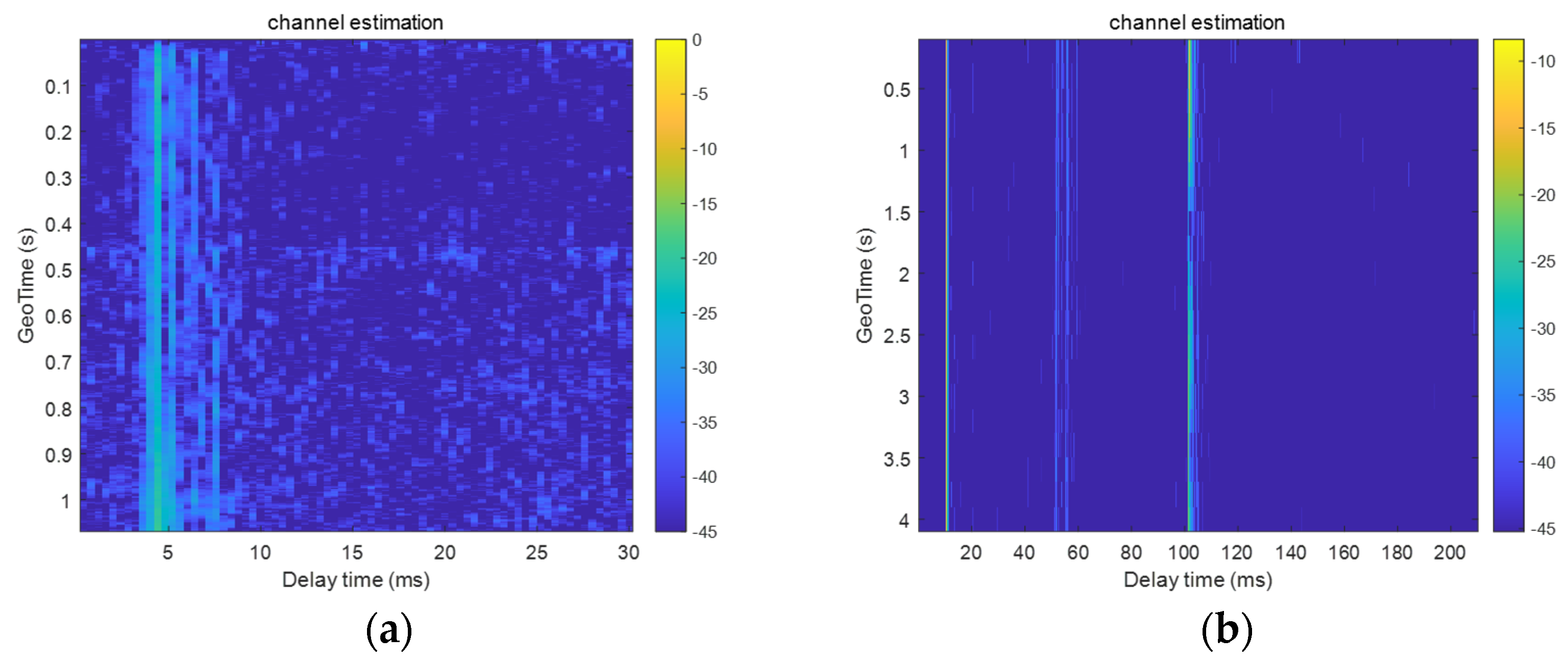


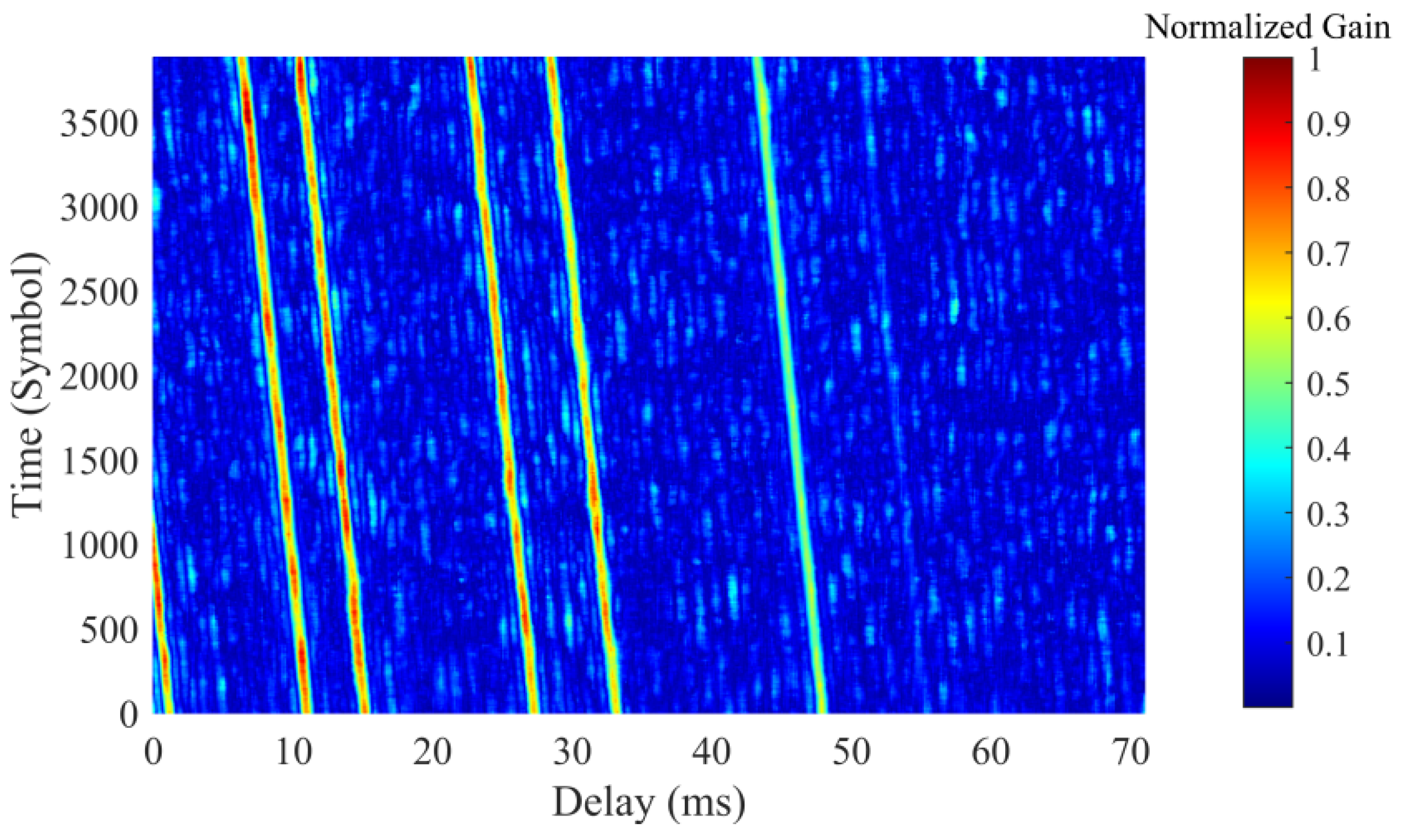
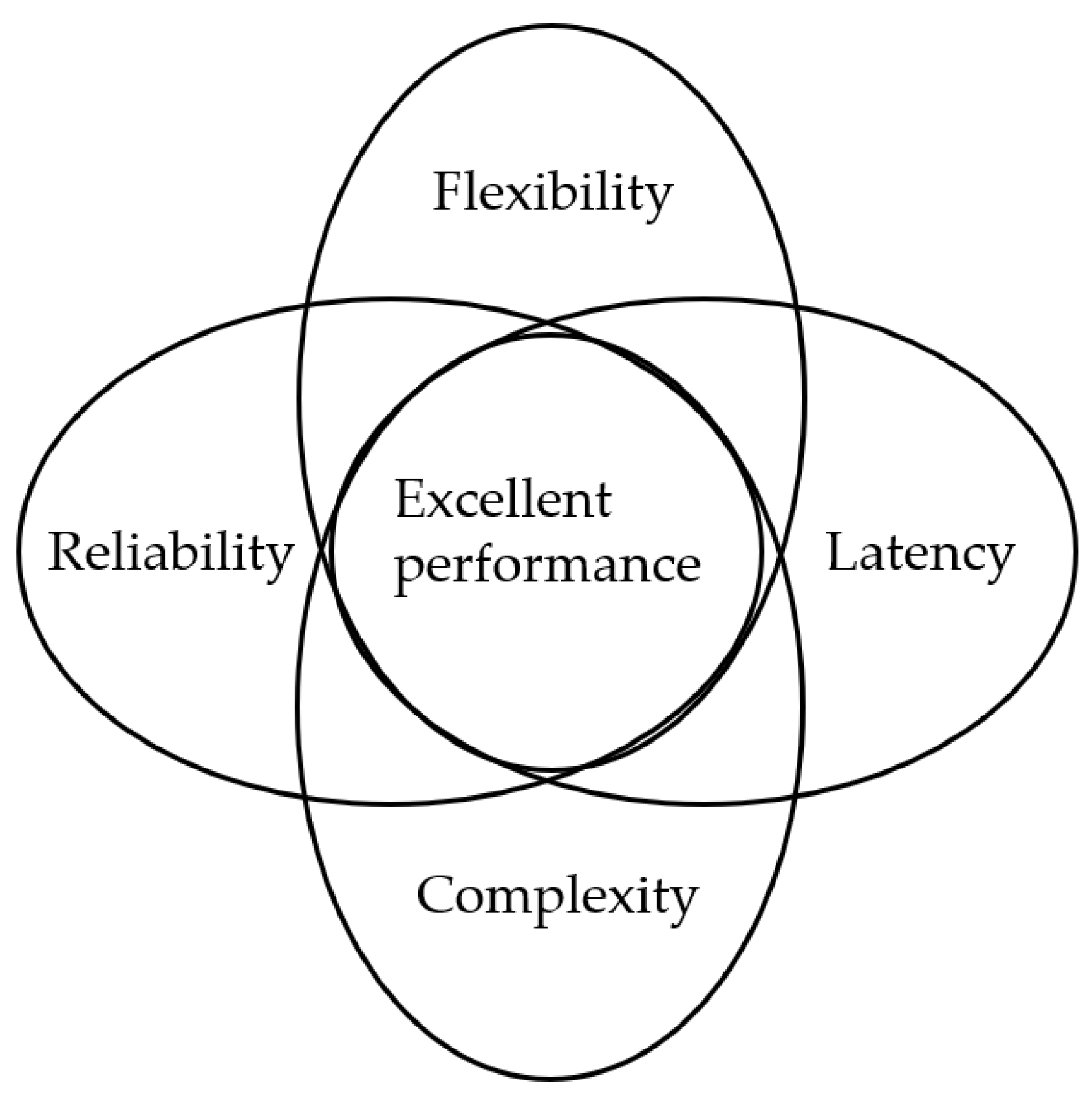

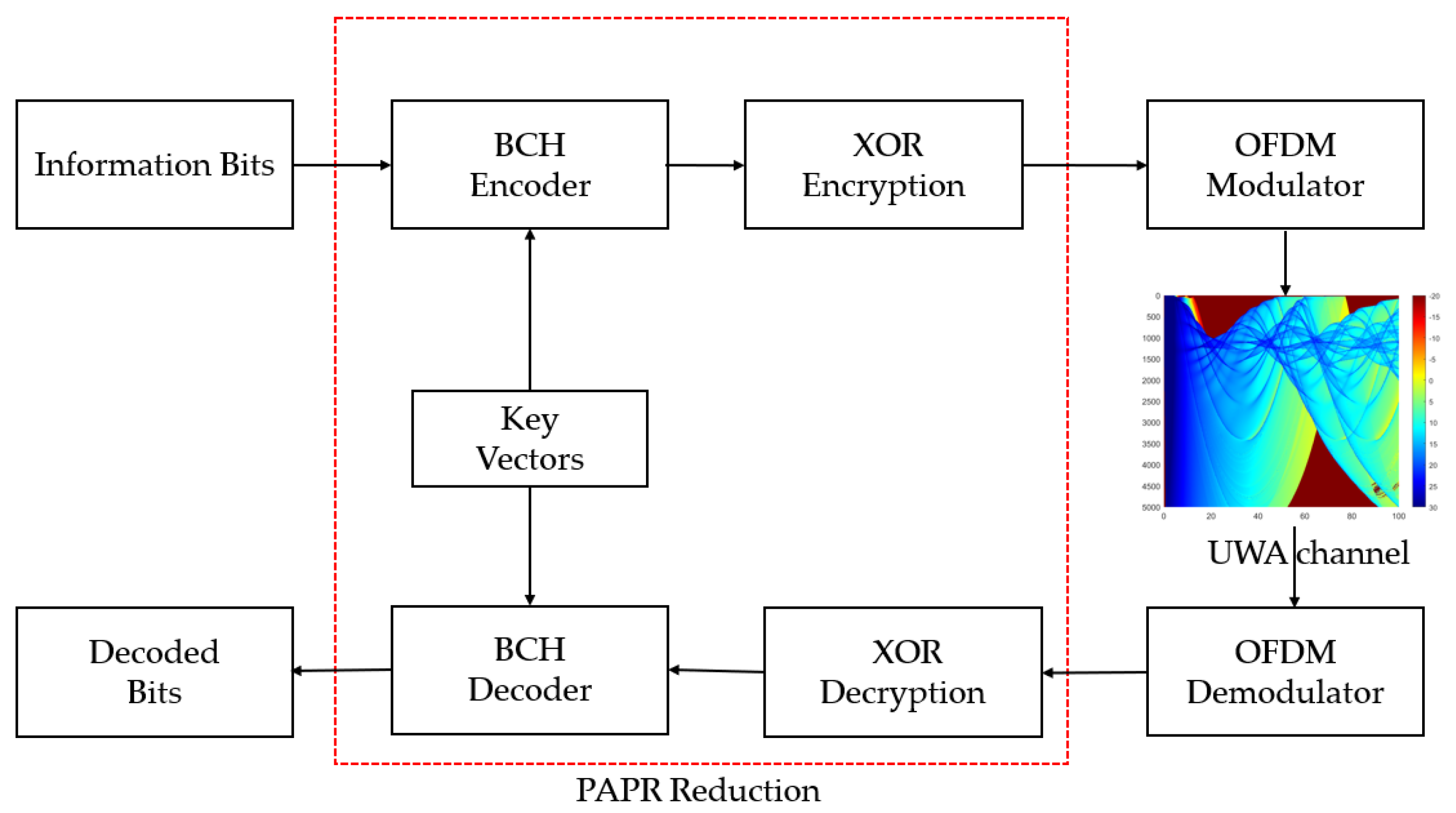

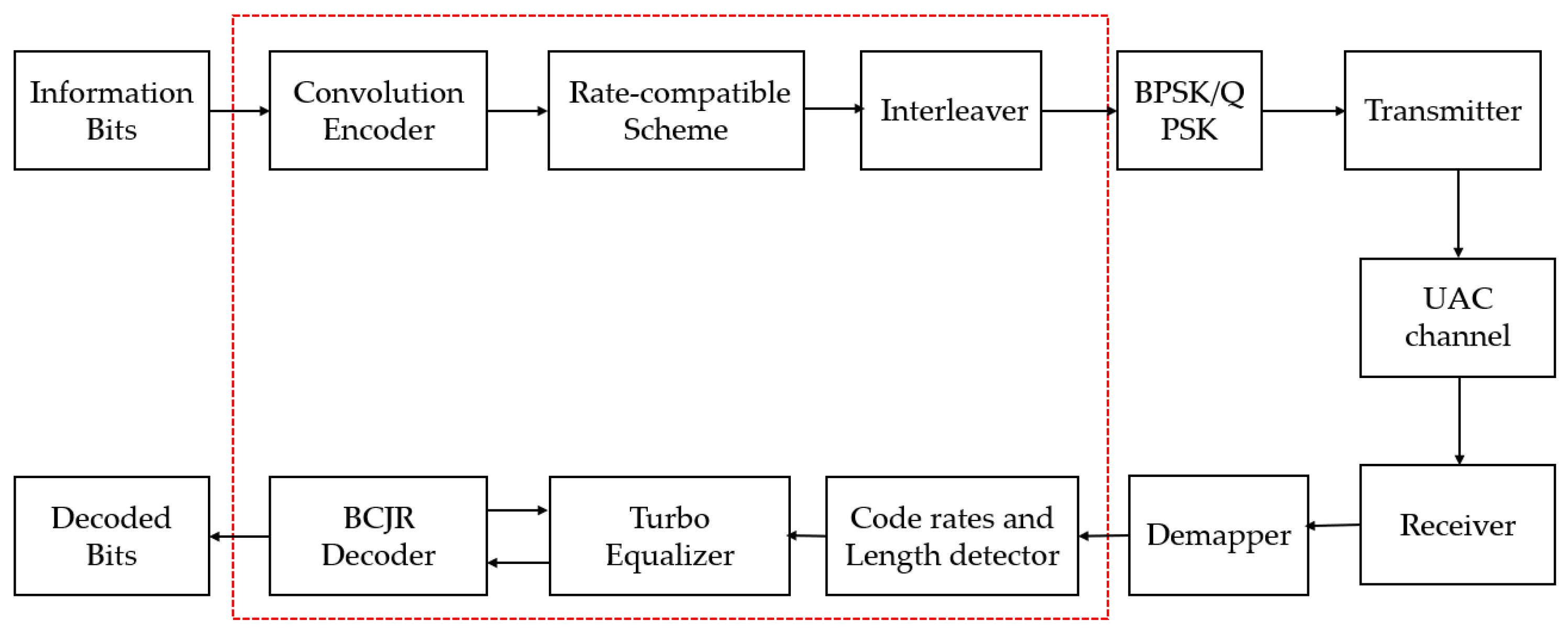
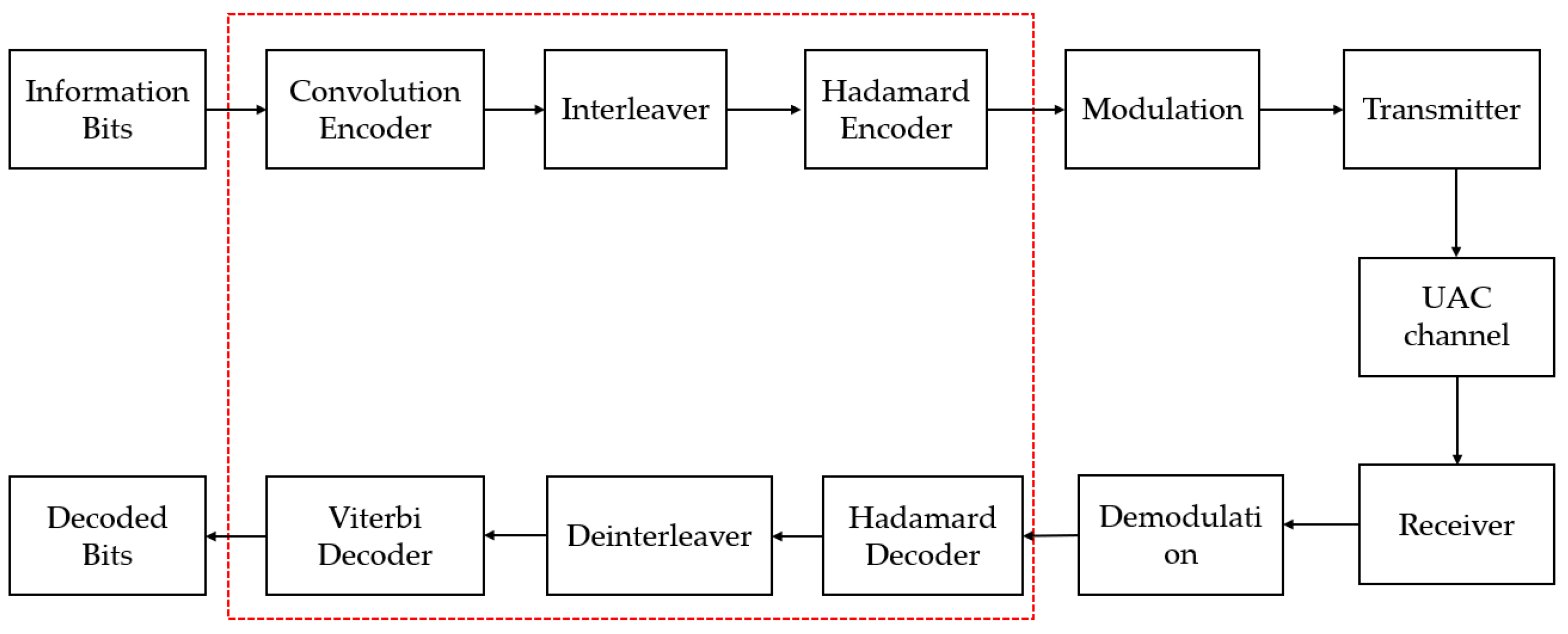


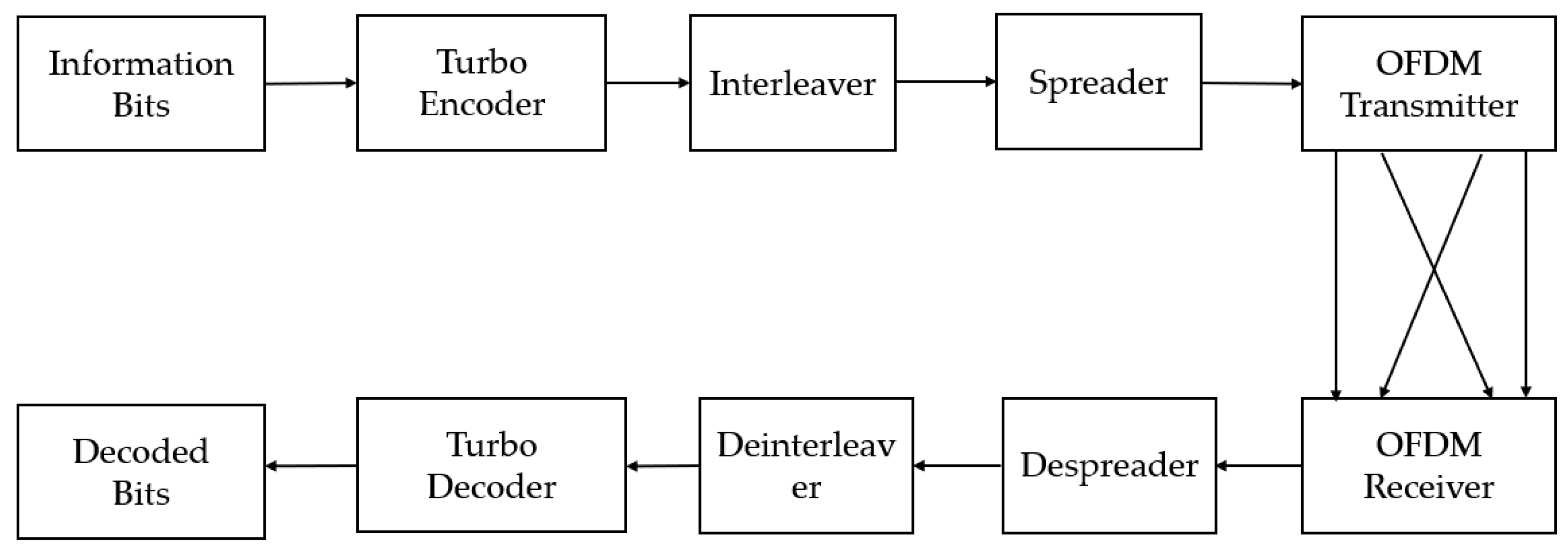
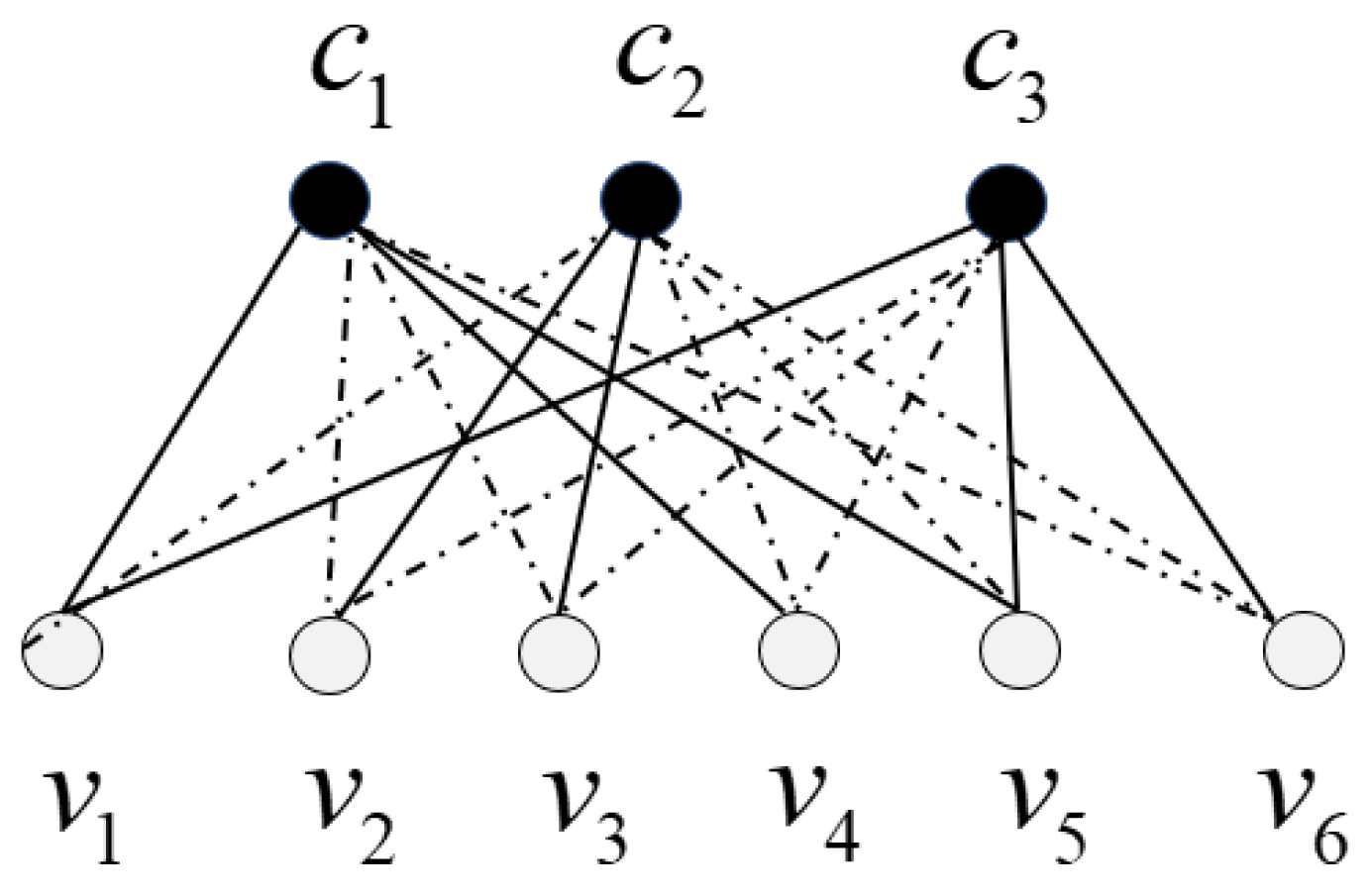
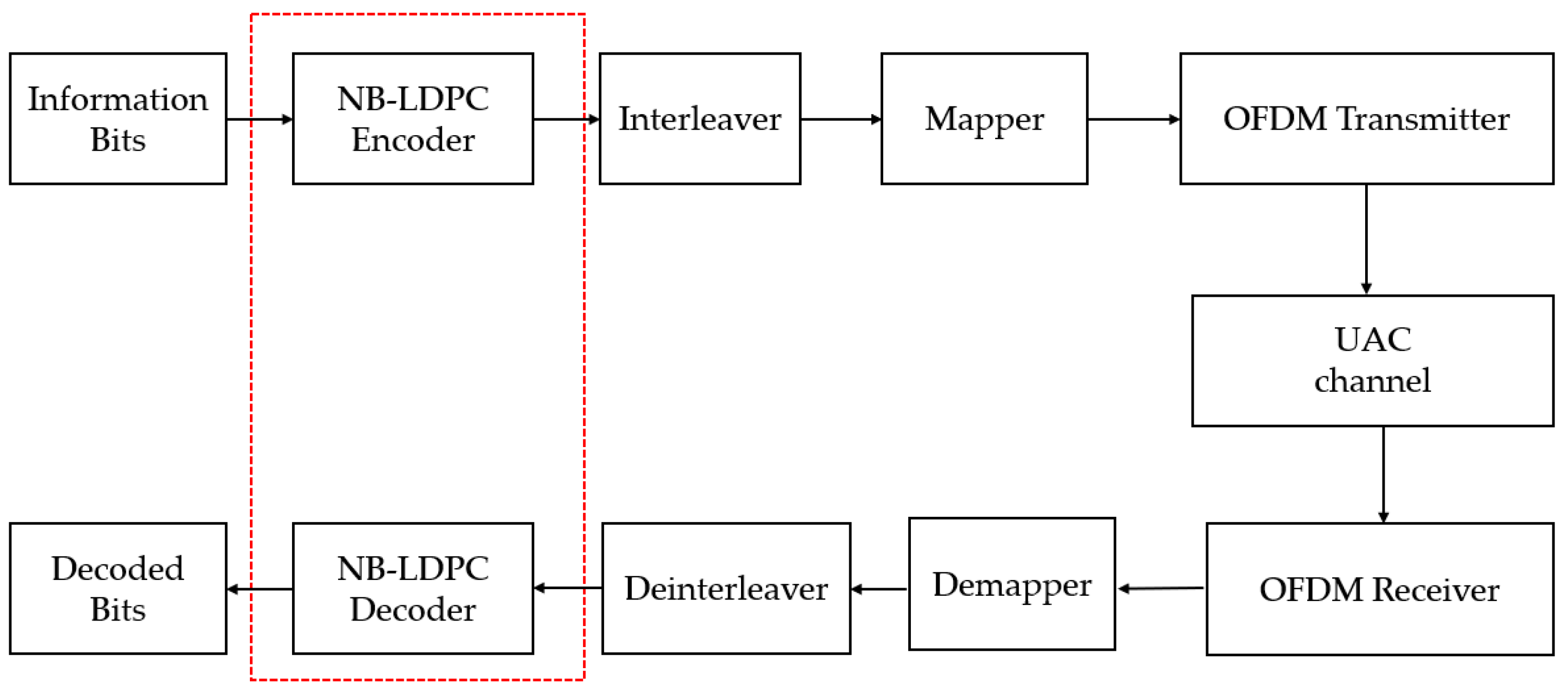
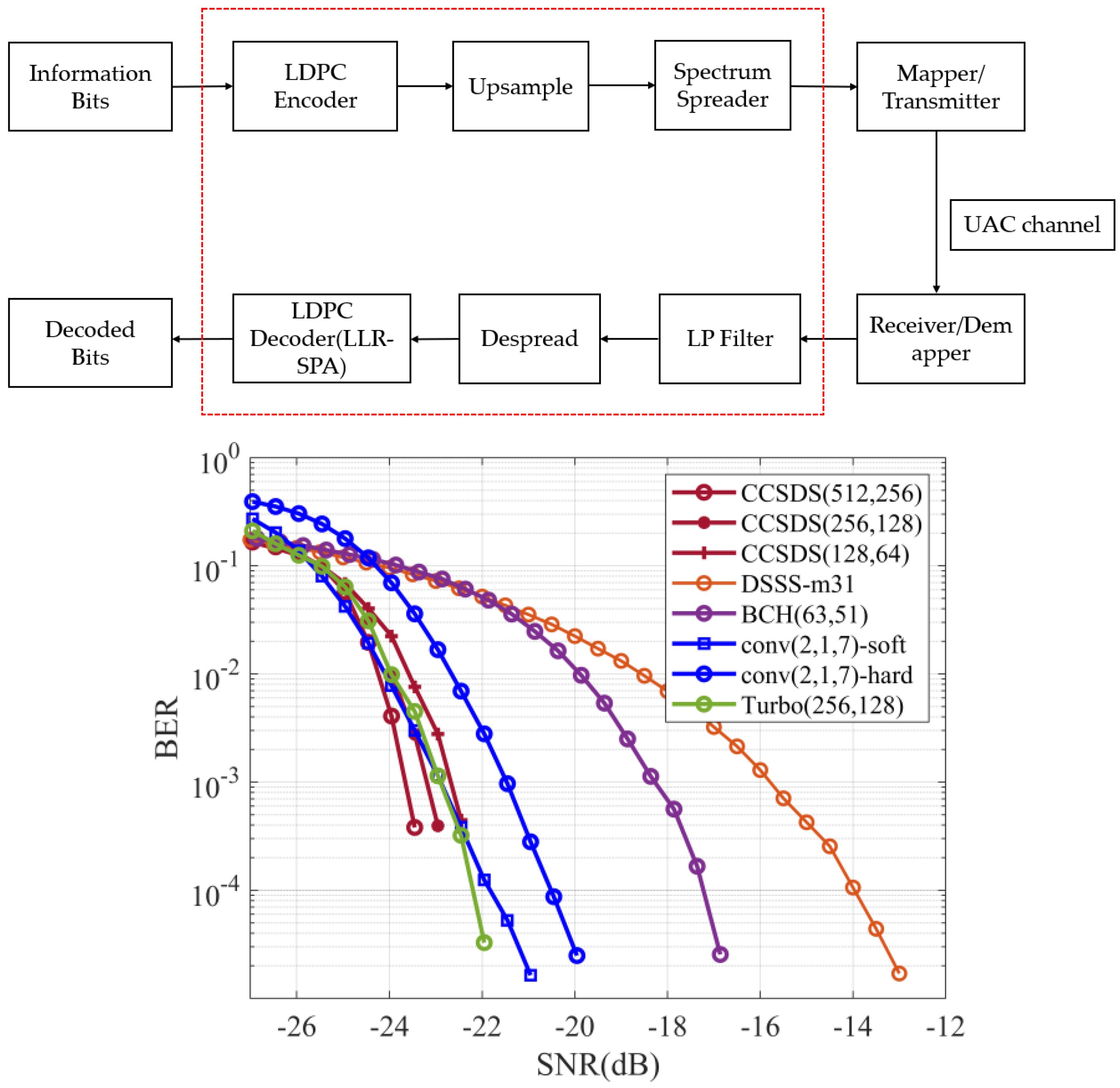
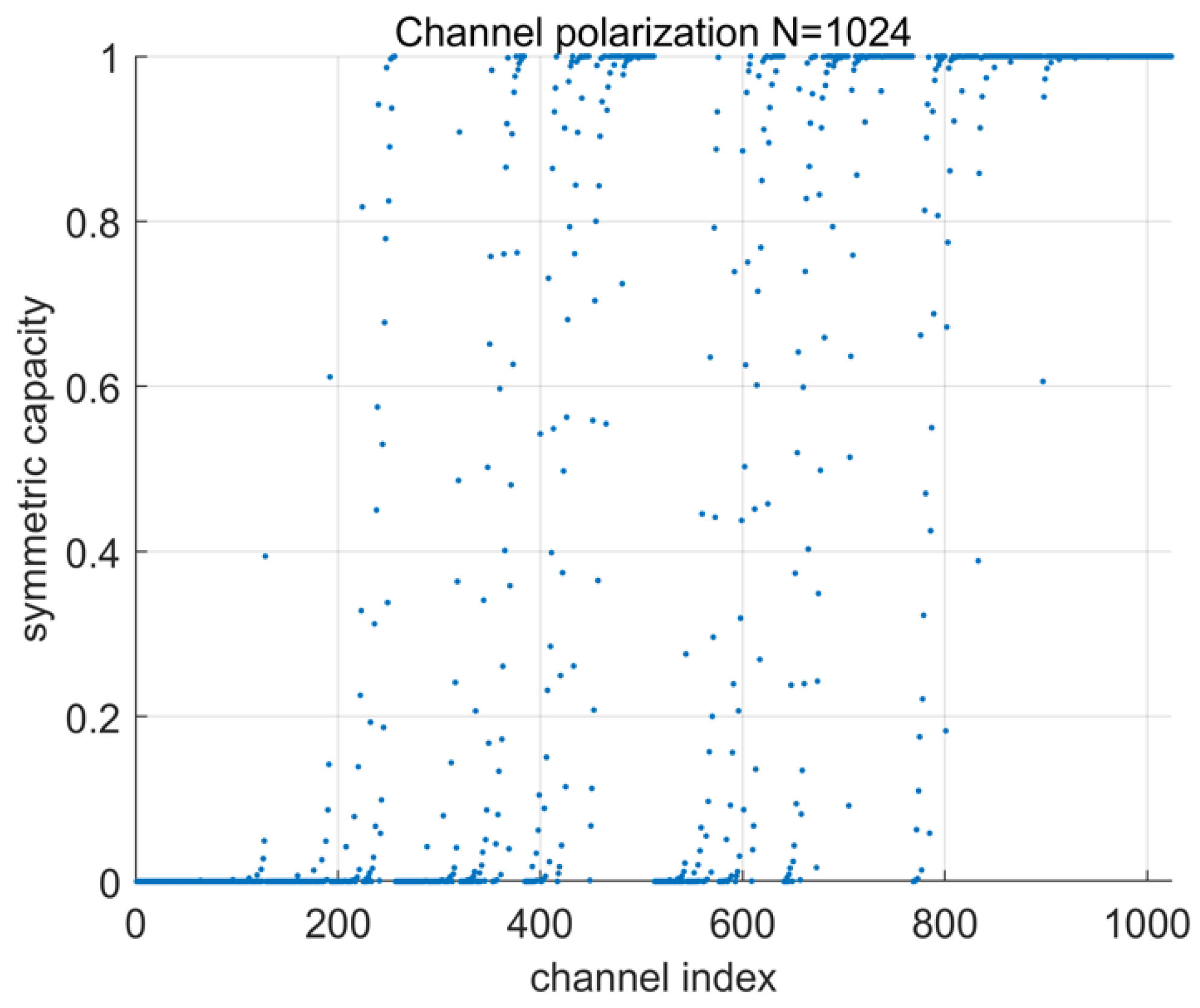

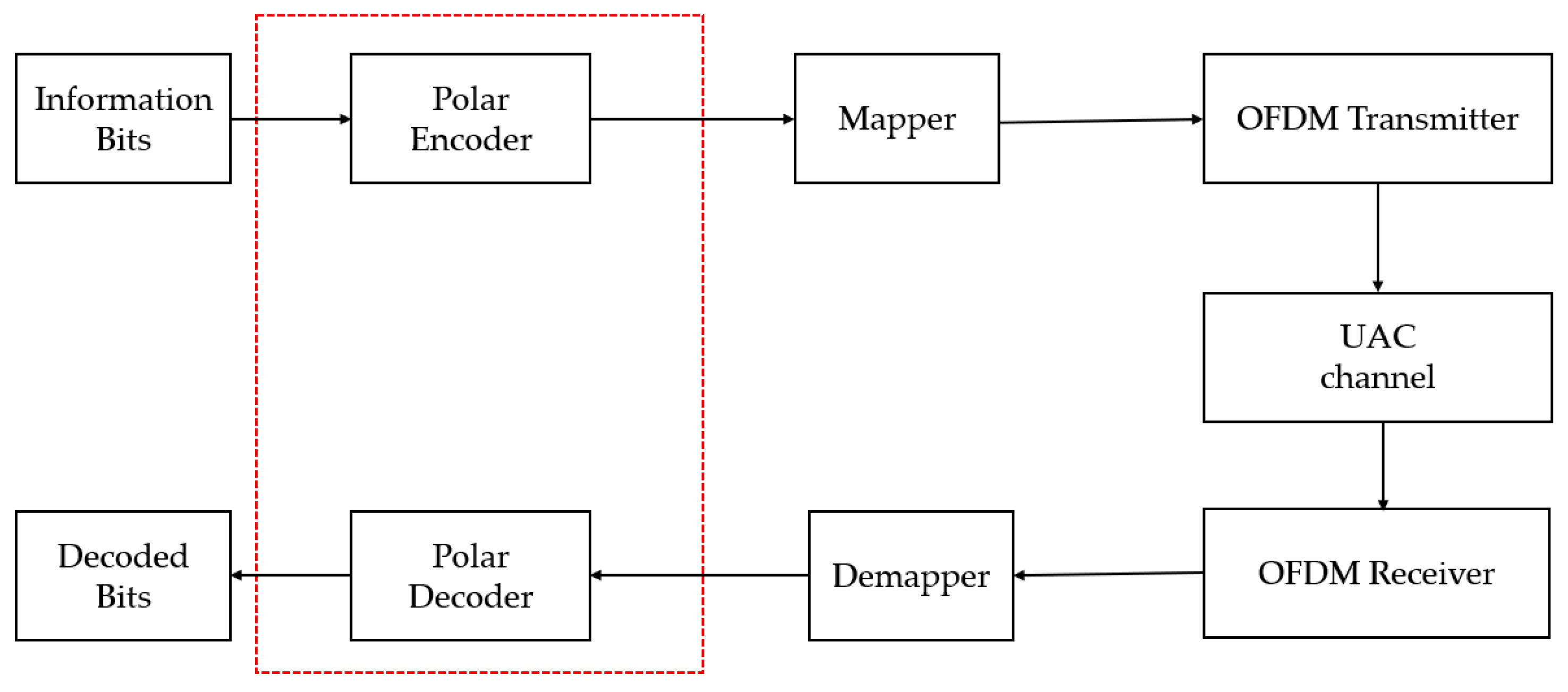
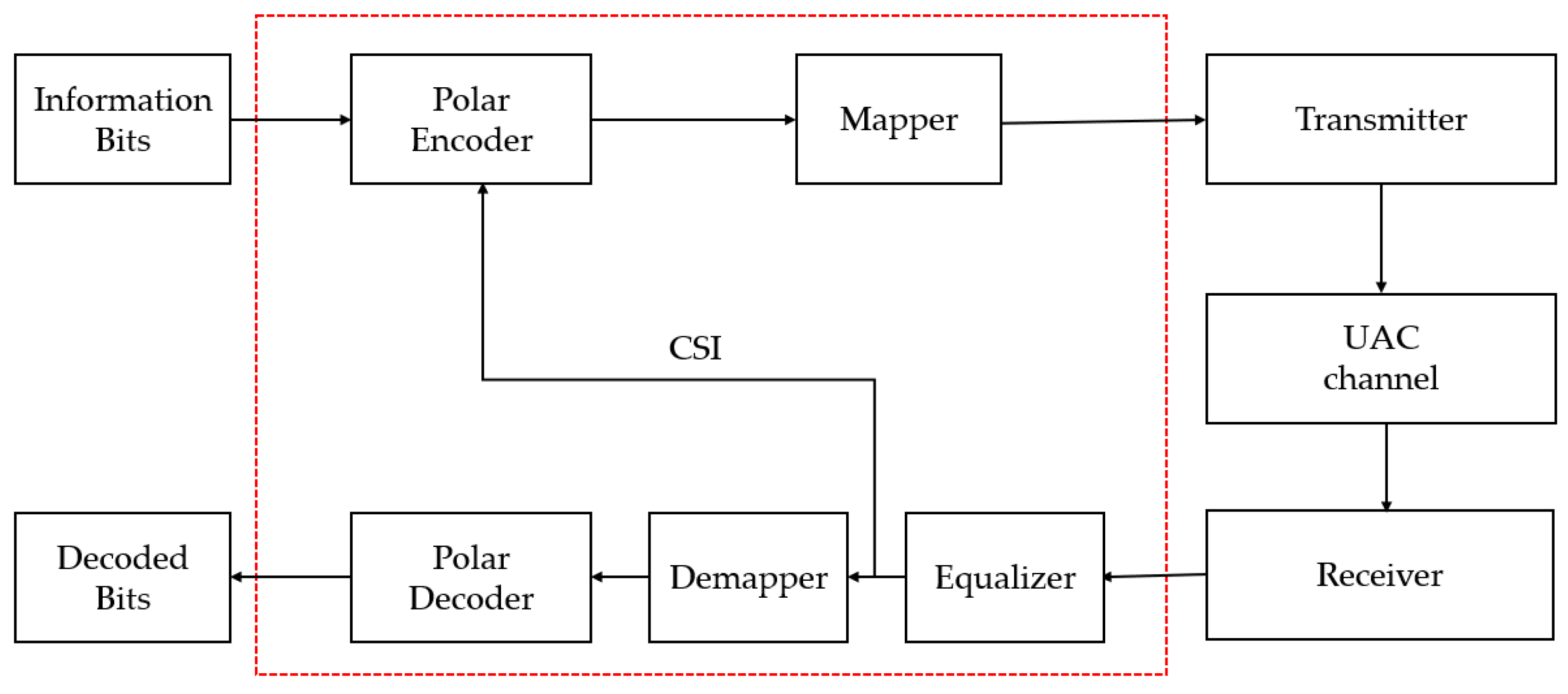
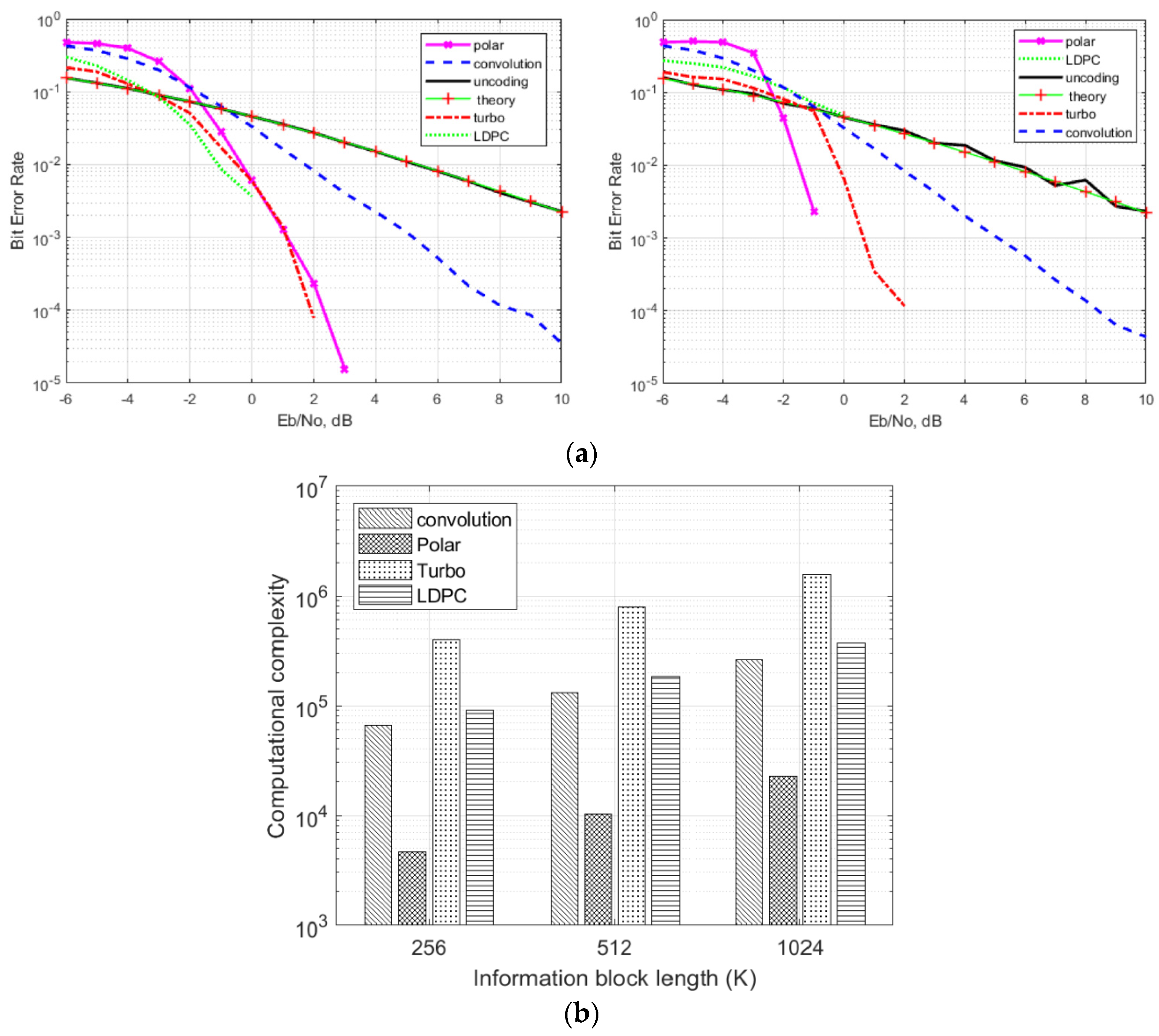

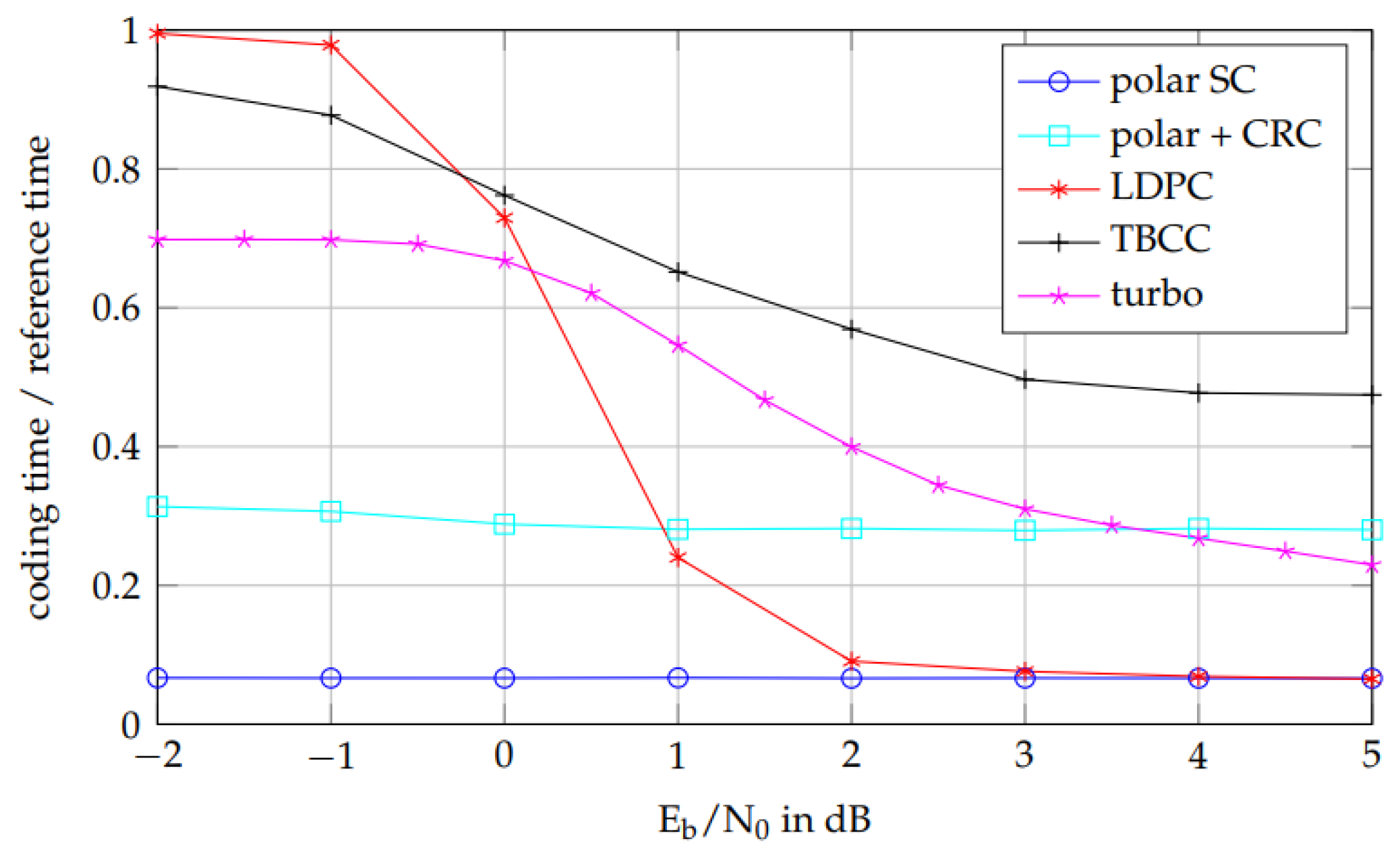
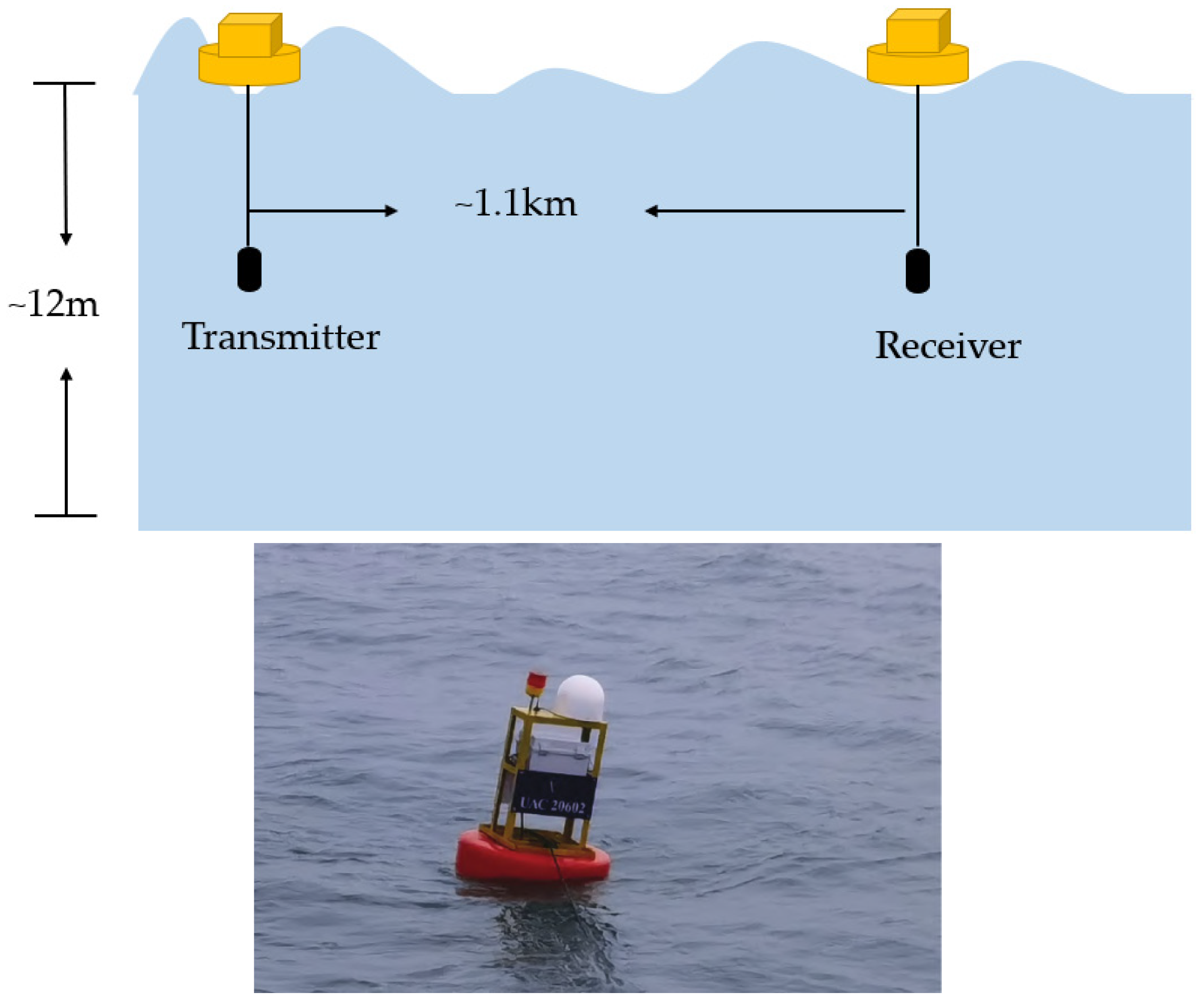
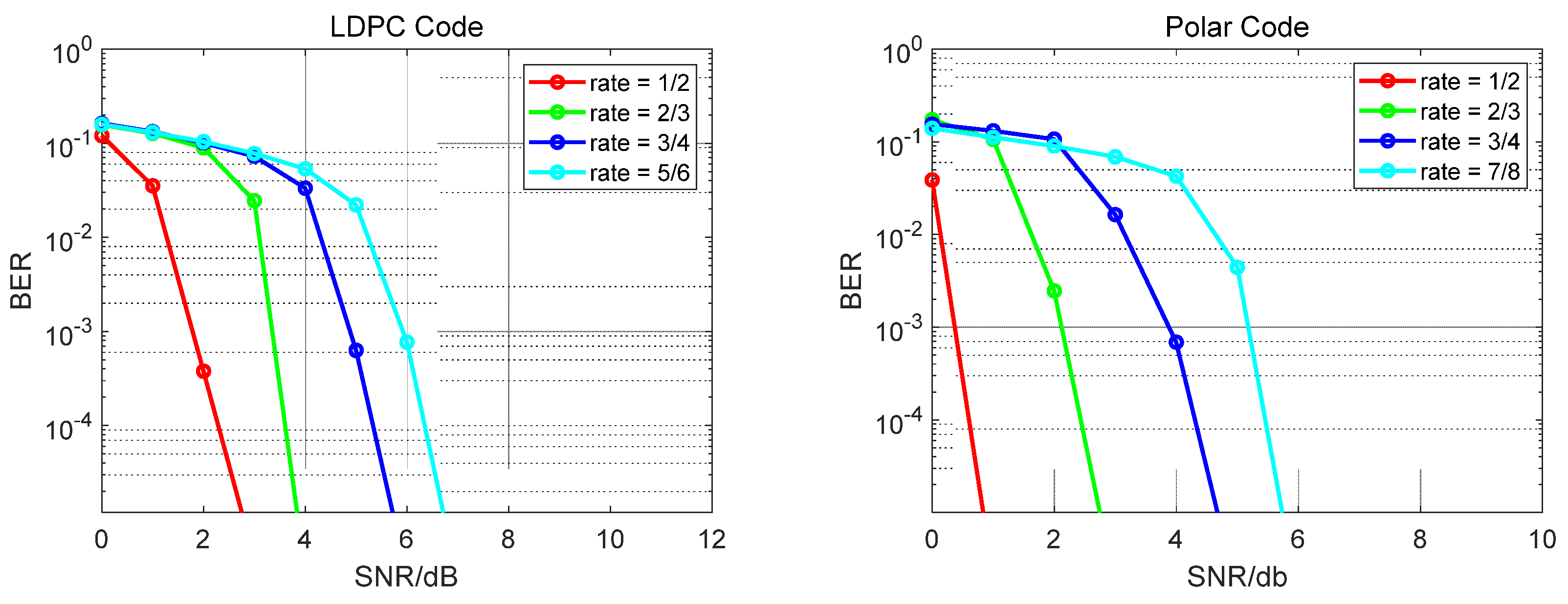
Disclaimer/Publisher’s Note: The statements, opinions and data contained in all publications are solely those of the individual author(s) and contributor(s) and not of MDPI and/or the editor(s). MDPI and/or the editor(s) disclaim responsibility for any injury to people or property resulting from any ideas, methods, instructions or products referred to in the content. |
© 2023 by the authors. Licensee MDPI, Basel, Switzerland. This article is an open access article distributed under the terms and conditions of the Creative Commons Attribution (CC BY) license (https://creativecommons.org/licenses/by/4.0/).
Share and Cite
Zhao, Y.; Hao, S.; Tong, F.; Zhou, Y.; Chen, D. Advances and Trends in Channel Codes for Underwater Acoustic Communications. J. Mar. Sci. Eng. 2023, 11, 2323. https://doi.org/10.3390/jmse11122323
Zhao Y, Hao S, Tong F, Zhou Y, Chen D. Advances and Trends in Channel Codes for Underwater Acoustic Communications. Journal of Marine Science and Engineering. 2023; 11(12):2323. https://doi.org/10.3390/jmse11122323
Chicago/Turabian StyleZhao, Yanfeng, Shuaifeng Hao, Feng Tong, Yuehai Zhou, and Dongsheng Chen. 2023. "Advances and Trends in Channel Codes for Underwater Acoustic Communications" Journal of Marine Science and Engineering 11, no. 12: 2323. https://doi.org/10.3390/jmse11122323




